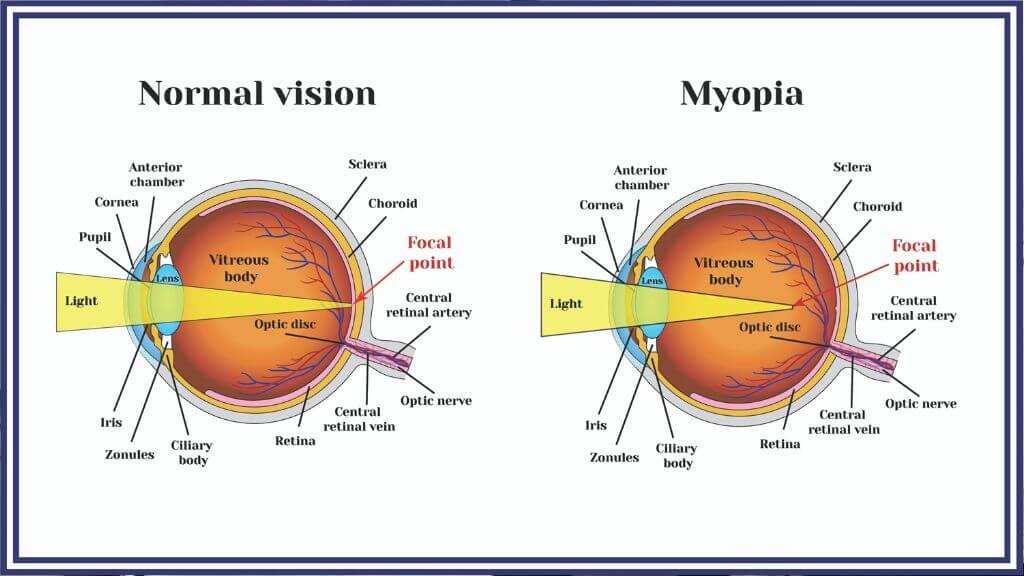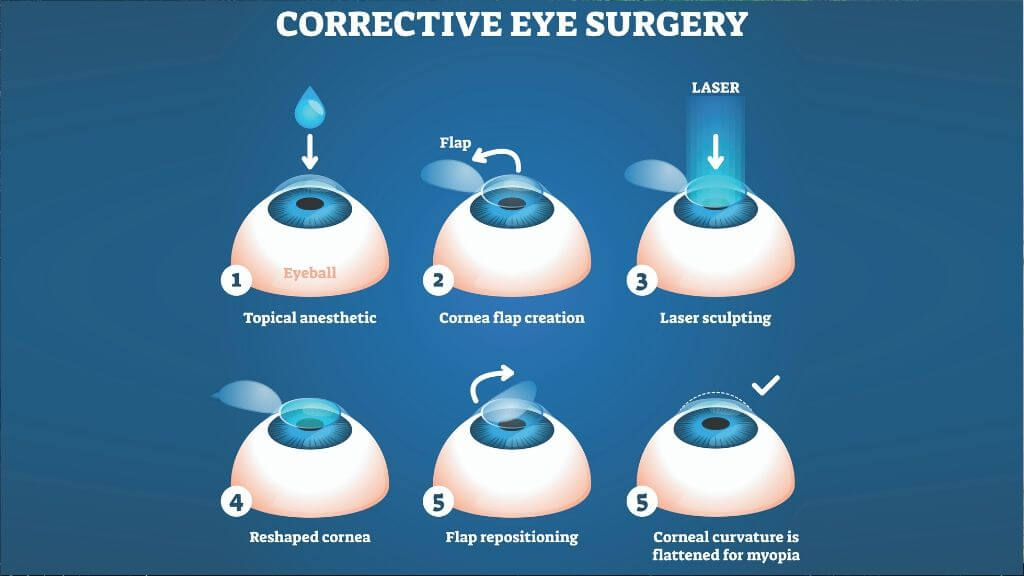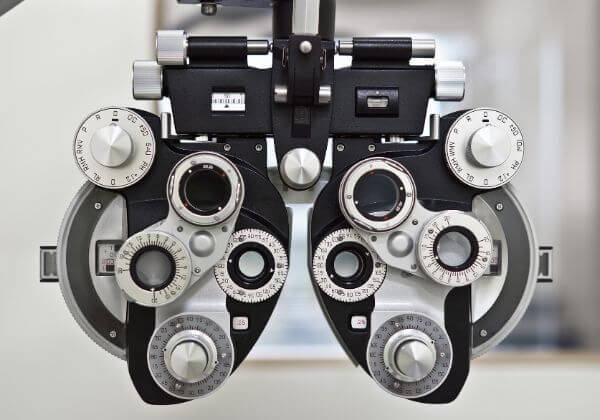A refractive error occurs when your eye doesn’t bend the light as it should. The shape of your eye prevents light from focusing correctly on the retina. These are the most common types of eye problems but can be easily identified with regular eye examinations.
What Causes Refractive Error?
The causes of refractive error vary according to the type you have. It is important to note that the overuse of the eyes does not cause or worsen refractive errors.
♦ Myopia is usually inherited and is typically identified during childhood.
♦ Hyperopia can also be inherited. When present in childhood, the condition can lessen into adulthood.
♦ Astigmatism occurs as a result of an asymmetrical curvature of the cornea. The light hitting the abnormally curved plane results in distorted vision.
♦ Presbyopia develops as a result of the lens becoming rigid with age. Not being as flexible results in an inability to focus.
In addition to these specific causes, refractive errors can result from eyeballs being too long or short and an irregular shaped cornea.
Your risk of refractive errors can be increased by the following factors:
♦ Family history of refractive errors
♦ Underlying condition like diabetes
♦ Eye trauma or surgery that damages the lens
Refractive Error Symptoms
Despite the different types of refractive errors, the symptoms are the same. Items appear blurry or distorted. The difference between the refractive errors is whether this distortion occurs with objects far away or nearby.
In general, refractive errors result in any of the following symptoms:
♦ Hazy vision
♦ Double vision
♦ Squinting
♦ Eyestrain
♦ Seeing a glare around lights
♦ Headaches
♦ Difficulty focusing
Some people may not notice symptoms despite a refractive error being present. Getting regular eye examination is important in identifying any vision problems early.

What Are the Variations of Refractive Error?
There are four common refractive errors.
♦ Myopia: Also known as nearsightedness, this condition causes far-away objects to appear blurry. The eyeball is too long, or the cornea is too curved, causing light to focus in front of the retina.
♦ Hyperopia: Also known as farsightedness, this causes nearby objects to look blurry. At advanced stages, vision becomes blurry at all distances. The eyeball is too short, or the cornea is flat, so light focuses behind the retina.
♦ Astigmatism: This refractive error can make far-away and nearby objects look distorted.
♦ Presbyopia:This causes middle-aged to older individuals difficulty in seeing items up close.
Refractive Error Diagnosis
Blurry vision can be caused by a number of factors. Refractive error has to be diagnosed by an eye care professional. An eye examination will be done, and you may also be given eye drops to dilate your pupils for a more detailed inspection.
There are several tests that can be used to diagnose refractive errors. You may need any one of these:
♦ Cover-uncover test: This determines if your eyes are aligned properly. While one eye is covered, your doctor evaluates movement of the uncovered eye.
♦ Refraction test: Your lens is checked as you look at a chart through different lens strengths.
♦ Visual acuity test: You are asked to look at different letters and color charts at varying distances.
♦ Test for fixation: You are asked to follow a light while one eye is covered. The test is done with both eyes.
Treatment for Refractive Error
Refractive errors can be corrected using eyeglasses or contact lenses. Glasses are the simplest and safest way to correct vision. Based on the testing with different lens options, you will be prescribed glasses that give clear vision.
Contact lenses also correct refractive errors, but they sit directly on the eye. Some people are uncomfortable with this, but they work as well as glasses. It is a personal choice as to which you opt for. There is no way to slow or reverse the progress of presbyopia.

Refractive Error Diet
There is no definitive cure for refractive errors, but the right diet can help you effectively manage them. Foods to include in your diet to promote eye health and manage refractive errors include:
♦ Spinach: Lutein and zeaxanthin are two powerful compounds found in spinach. These antioxidants are proven to prevent macular degeneration as well as light damage. Spinach is a great dietary choice for those with myopia as it strengthens the eye against further damage.
♦ Almonds: Almonds are full of antioxidants and protein. These work to slow the oxidative damage that can worsen refractive errors. Snack on almonds throughout the day, or mix the almond powder into a healthy shake to boost optical health.
♦ Carrots: Carrots have been considered the best vegetable for eye health for centuries. The high beta-carotene content nourishes the eye and is directly linked to protecting the retina.
Natural Treatments for Refractive Error
In addition to corrective actions to get clear vision, there are additional things you can do to manage refractive errors.
♦ Bilberry extract: Bilberry is one of the best sources of anthocyanins, which are proven to boost eye health. Adding a bilberry supplement to your diet can boost vision and prevent further degradation from refractive errors.
♦ Reduce screen time: Blue light emitted from screens is the most dangerous light for your eyes. Excessive exposure increases your risk of degenerative eye conditions. Blue light can penetrate directly back to the retina, causing damage to the light-sensitive cells. By reducing screen time and taking breaks, you can protect your eyes.
♦ Quit smoking: Tobacco increases the risk of many diseases, including eye diseases. Long term use can lead to vision loss. Smoking cannot directly cause refractive errors, but as it deteriorates the health of the eyes, these errors can get worse. Quitting is the best way to protect your eyes from further damage.
Refractive Error Statistics
♦ Approximately 153 million people globally are visually impaired due to uncorrected refractive errors.
♦ Women experience refractive errors more often than men.
♦ Myopia is the leading cause of visual impairment, affecting close to 1.9 billion people worldwide.
♦ Hyperopia affects approximately 10 percent of the U.S population.
Astigmatism occurs in about 1 in 3 people.

Refractive Error and Surgery
In some cases, surgery is required to correct refractive errors. The most common type of surgery is LASIK surgery. The procedure uses lasers to change the shape of the cornea to make vision clear. It works for all refractive errors except presbyopia.
The procedure starts with a scanner taking a detailed image of the cornea. Drops are placed in your eyes to numb them. A small flap is cut in the cornea, and a laser shines into your eye. The laser changes the cornea shape, and the flap is replaced.
There are certain conditions that can increase the risk of complications from LASIK. If you have any of the following, LASIK surgery may not be a safe option.
♦ Dry eye
♦ Eye infections
♦ Glaucoma
♦ Cataracts
♦ Large pupils
Refractive Error and Children
Most full-term infants are born mildly hyperopic. Vision gradually improves over the course of their first year of life. By the age of 12 months, only 3.6 percent of children still have this hyperopia. Other types of refractive errors can occur in children, with the exception of presbyopia.
Without correction, these vision problems can be harmful to development. It is important to have your children’s eyes checked regularly so any vision disturbances can be corrected right away.
What Is the Long-Term Outlook?
Most refractive errors can be successfully corrected when identified early. Early treatment is essential in preventing social and academic challenges in childhood. With regular eye examinations, you can identify refractive errors and seek treatment.
Children and adults can live healthy lives with refractive errors as long as corrections are made right away. You can also prevent refractive errors by promoting eye health by wearing protective eyewear, eating a balanced diet, and taking breaks from the computer.






